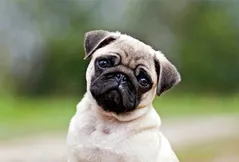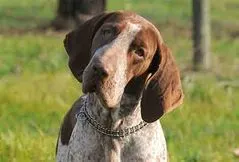
Pug
With a round head, square body, curly tail, Pug is always good with other dogs, cats, and children.
Overall Status
| Height | 10 to 13 inches |
| Temperament | Charming, Mischievous, Loving |
| Weight | 14 to 18 pounds |
| Life Expectancy | 12 to 14 years |
| Coat Color | Black, Silver |
| Barking Level | Medium |
Quick Factors
| Playfulness | |
| Dog Friendly | |
| Exercise Need | |
| Grooming Needs | |
| Strangers Friendly | |
| Family Affectionate |
Daily Care
Grooming Tips
Grooming a Pug’s coat is easy. Brush his smooth double coat weekly with a rubber curry brush to remove dead hair. And you will remove lots of it, because Pugs shed. A lot. They shed year-round, so it’s something you should expect to live with.The Pug’s facial wrinkles, especially the deep nose roll, must be cleaned. Each Pug is an individual, so you may have to clean them daily or only weekly. Wipe out the crud with a dampened cosmetic sponge or baby wipe, then thoroughly dry the wrinkles so they don’t mildew or become infected, a condition known to Pug people as “swamp face.”Bathe the Pug as needed. With the gentle dog shampoos available now, you can bathe a Pug weekly if you want without harming his coat.The rest is basic care. Trim the nails every week or two, and brush his teeth often — with a vet-approved pet toothpaste — for good overall health and fresh breath.
Exercise Tips
Pugs aren’t big exercisers by instinct, but they’ll be perfectly capable of handling much of what you throw at it – just keep in mind that their short legs and heavier torso can make things a little less easy for them.Since these dogs are prone to obesity, much like Bulldogs, it’s important to make sure that you exercise your Pug regularly. such as walks or play sessions in the yard.It’s vital to remember that as a short-faced breed Pugs aren’t tolerant of hot weather, and they shouldn’t do strenuous exercise when it’s warm or humid out—better to be in air-conditioning.Some canine sports in which Pugs participate and excel includeagility,obedience, andrally. The Pug’s general friendliness makes for a good city dog, which means that walking your dog in a busy city is a treat.
Feeding Tips
Pugs don’t have a highly specific diet as far as dogs go – meats, vegetables and unprocessed foods generally work the best. Be sure to watch your dog’s weight, however, as its short legs can lead to joint problems down the line. A Pug should have a slightly odd torso-to-leg ratio, but it’s best not to exceed this to the point that your Pug is overweight.Any diet should be appropriate to the dog’s age (puppy, adult, or senior). Treatscan be an important aid in training, but giving too many can cause obesity. Learn about whichhuman foodsare safe for dogs, and which are not. Check with your vet if you have any concerns about your dog’s weight or diet.Clean, fresh water should be available at all times.
Health Tips
The average lifespan of a healthy Pug is between 12 and 14 years, but the breed is prone to several health conditions that can dramatically affect the life of these animals. The lack of a prominent snout in this breed puts the Pug at risk for several eye conditions and injuries, such as entropion and proptosis.Dogs of this breed that are not given opportunities for exercise and a proper diet have a higher risk of developing obesity than other dogs. Also, the dog’s quintessential wrinkles on its face require special cleaning because of the risk of infection and irritation developing in that region.There are several hereditary disorders that commonly afflict the breed. A major condition is known as necrotizing meningoencephalitis, or NME, commonly presents itself in dogs of this type, and it leads to an incurable inflammation of the dog’s brain. This condition usually shows itself before the dog is seven years old. The Pug is also prone to the development of a condition known as hemivertebrae. It is this property that gives the breed its distinctive screwtail, but it is possible for this curvature to develop in other parts of the spine when a Pug puppy's body is growing.
Trainability
Pugs are generally considered a companion dog; they were often bred for royalty as“lap” dogsand can be seen in painting as living out that exact role. For that reason, they are well-suited for city and apartment life.He has an even and stable temperament, great charm, and outgoing, loving disposition. Pugs live to please their people, so they are generally easy to train.Pugs are great around children but can be strong-willed and thus difficult to train if you don’t have a lot of experience in handling dogs.Their feelings are easily hurt, and harsh training methods should never be used. A Pug wants to be with his family and will be unhappy if he is regularly left alone for long periods of time. Earlysocializationandpuppy training classesare recommended.
History
Pugs probably originated in China, but not much is known about their early history. Experts believe that the short-coated, wrinkle-faced dogs were brought to Holland by Portuguese traders in the 16th century.They became popular in the Dutch royal court and made their way to England in 1689 when Dutch rulers William and Mary took over the English throne after the overthrow of Mary’s father, James II. Ever since Pugs have been popular with rulers and the rich and famous. Among their admirers were King Louis XIV; Josephine, empress to Napoleon; Queen Victoria; the Duke and Duchess of Windsor; and fashion designer Valentino.TheAmerican Kennel Club (AKC)began registering Pugs in 1885. Today, the Pug ranks 24th among the breeds registered by the AKC. That’s down somewhat from his 15th-place position in 2000, but it still puts him in the top 25, comfortably popular.






